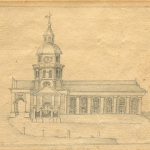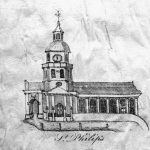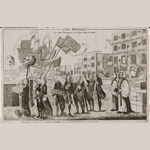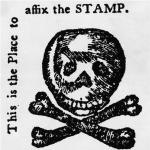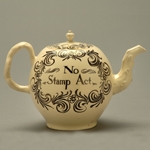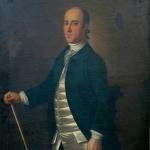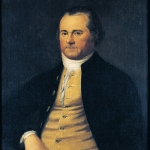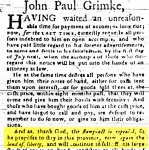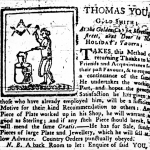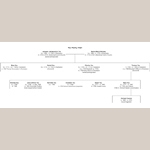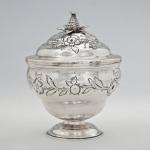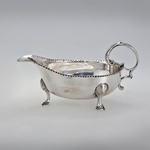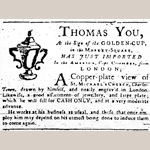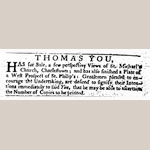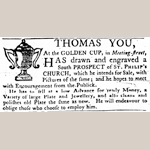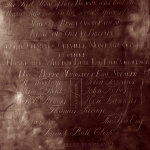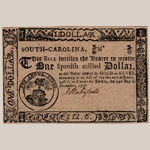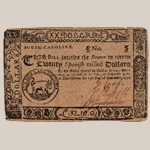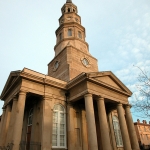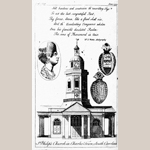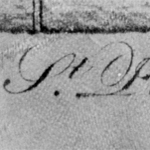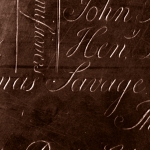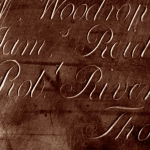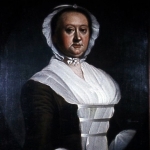Some twelve years before the Declaration of Independence, British Parliament enacted legislation that sparked revolution in America. The Stamp Act of 1765 is recognized as the catalyst that first unified the American colonies as a collective body to protest British rule. More difficult to discern is how individual Americans reacted to the Stamp Act through their business practices and products. Charleston silversmith and engraver Thomas You is a notable exception.
The effects of British policies on You’s business in the mid 1760s drew him into a circle of like-minded artisans that influenced his shop practices and products. Evaluation of two previously unattributed eighteenth-century images of Charleston’s St. Philip’s Church (Figs. 1 and 2) and Thomas You’s surviving work, newspaper advertisements, and personal and business associations coalesce to establish him as one of the city’s Sons of Liberty, a collection of craftsmen that was the crucible for revolution in the Carolina Lowcountry. Along the way previously unknown information about Thomas You’s family, training, and heritage is revealed.
The Stamp Act Crisis of 1765-1766
British Parliament enacted the Stamp Act in 1765 as an attempt to recover costs for defending the English colonies during the French and Indian War. Parliament required that all paper used for governmental purposes, newspapers, pamphlets, and playing cards display a duty stamp. Colonial resentment of the act, both North and South, was quick and fierce for a number of reasons but primarily because the tax applied only to American colonists and was passed without approval of the colonial governments (Figs. 3, 4, and 5). In effect, the Stamp Act was the flame that lit the “taxation without representation” rhetoric central to the American Revolution.[1]
When the Stamp Act was passed in the spring of 1765, Americans reacted politically and commercially. Politically, a Stamp Act Congress was convened in New York where colonial representatives attempted to obtain a repeal by petitioning Parliament. Commercially, colonists called for boycotts of imported British goods.[2]
American craftsmen were a vocal component of political protest, both during the Stamp Act Crisis and after. Rosemary Estes summarized the impact of those craftsmen: “Artisans, who had generally been uninvolved in politics, suddenly took to the streets in protest against British taxation, and in the following ten years formed the core of radical groups that became known as Sons of Liberty… Their vehemence against British policies did not abate as suddenly as it arose, but remained strong throughout the Revolutionary period… .”[3]
Craftsmen and merchants in Boston, New York, and Philadelphia signed written boycotts of imported wares. In Charleston, citizens stopped short of a formal boycott but many individual merchants and consumers did boycott English goods. One reason that Charlestonians may have restrained from formalizing the boycott is because of the city’s strong and long-standing economic ties to England. Unlike its northern counterparts, the Carolina Lowcountry was a significant producer of agricultural goods for export and a ravenous consumer of British-made goods.[4]
In tandem with the boycott of English-made goods, colonists also protested the act by encouraging the purchase of American-made goods. An editorial signed “A Patriot,” originally published in New York but widely reprinted, encouraged Americans to, “zealously endeavor to promote the produce and manufacture of this country.”[5]
The first form of protest to the Stamp Act in South Carolina took place in the colony’s Commons House of Assembly during June of 1764. Upon learning of a proposed bill to create a stamp tax on the colonies, Commons House of Assembly members sent a barrage of correspondences to the colony’s London agent, Charles Garth, urging him to block the passage of the bill. Their attempts to block the tax through argument fell on deaf ears in London. After the Stamp Act was passed in the March 1765, South Carolina sent three delegates to New York to participate in the Stamp Act Congress, convened in October 1765 to force Parliament to repeal the tax.[6]
Charlestonians also made their dissatisfaction known through public demonstration. More than two thousand citizens took to the streets in July 1765 to protest the passage of the tax. In October, 150 people reportedly marched on Fort Johnson to confiscate stamps that had arrived on the ship Planter’s Adventure. Gallows were erected in the most prominent spot in the city, at the intersection of Broad and Church streets, and hanging from them was an effigy of a stamp collector.[7]
The effects of the colonial boycott, public protests, and the Stamp Act Congress were eventually successful in influencing Parliament, and in March 1766 the tax was repealed. Charleston merchant Christopher Gadsden (Fig. 6), however, was still not satisfied. Gadsden had been a delegate to the Stamp Act Congress in New York and correctly predicted that Parliament would levy future taxes on the colonies.[8] In the summer of 1766 a group of about twenty-five tradesmen gathered under the “Liberty Tree” in Charleston to hear Gadsden’s warnings of future tax-related attacks on colonists by Parliament. The tradesmen of Charleston maintained the mantle of protest against taxation after the repeal of the Stamp Act and formed the core of the city’s Sons of Liberty for the next ten years.
Charleston’s Sons of Liberty
Under Gadsden’s leadership, Charleston’s Sons of Liberty had at least forty members. Of the forty identified, thirty-five were tradesmen, including builder Daniel Cannon and newspaper publisher Peter Timothy. To construct a concise and complete list of Charleston’s Sons of Liberty is not possible, even today. Secrecy shrouded the organization, as would be expected; however, an attendee of Gadsden’s 1766 Liberty Tree gathering did covertly record the names of those present. More members can be identified through their participation in a variety of committees that combated Parliamentary legislation leading to the Revolution.[9]
Comparing the patriots in Charleston’s overall craftsman community with the active members of the city’s Sons of Liberty reveals how Gadsden’s group was driven almost completely by artisans. The percentage of patriots in the larger craftsman community in Charleston was relatively small (5 percent), but the percentage of the city’s Sons of Liberty who were tradesmen was significant (88 percent). Among the forty Charleston craftsmen identified in MESDA’s Craftsman Database as “patriots” there are thirteen trades represented. They include carpenters (8), clockmakers (5), blacksmiths (5), silversmiths (4), shipwrights (3), master builders (3), cabinetmakers (3), surveyors (2), gunsmiths (2), and chairmakers (2), as well as an umbrella maker, a tinsmith, and a brass founder.[10]
All of the craftsmen identified as members of the Sons of Liberty were masters of their trades, not journeymen or apprentices. They were businessmen directly impacted by the Stamp Act. The taxes levied against Charleston’s consumers meant less currency available to purchase goods. The resulting pressure on local shops was immediate and demanded action on the part of business owners.[11]
If Charleston’s boycott of imported British goods during the Stamp Act Crisis was not as formally organized as those in Boston, New York, and Philadelphia, advertisements in the South Carolina Gazette reflect that indeed a boycott was in place. Upholsterer and cabinetmaker Edward Weyman’s (Fig. 7) business before the Stamp Act had heavily relied on imported goods such as looking glasses, coffin furniture, cabinetmaker’s tools, and supplies. The year of the Stamp Act Crisis, he emphasized looking glasses made in his own shop, advertising that he had procured the services of two workmen and at a great expense had brought “as great Perfection as in Europe.”[12]
The crisis nearly pushed jeweler and silversmith John Paul Grimke (b.1713–d.1791; w. 1731–1772) back to England. Grimke was a prominent artisan in Charleston at the time of the Stamp Act Crisis. In August 1765 he announced in the South Carolina Gazette that he intended to return to London.[13] Nearly a year later—and three months after the Stamp Act was repealed—Grimke placed an advertisement that stated, “And as, Thank God, the stamp-act is repealed, so he proposes to stay in this province, now again the land of liberty…” (Fig. 8).[14] Any boycott of imported goods in Charleston was completely ended by October 1766 when Grimke explicitly announced that “since the repeal of the Stamp-Act” he was once again receiving goods from London.[15]
John Paul Grimke’s intent to return to England rather than to continue running his well-established jewelry and silversmith shop under the oppressive taxes imposed on the colonies is significant. Grimke’s shop had celebrated its twenty-fifth anniversary a year earlier and over that quarter century his frequent advertisements consistently included an impressive list of jewelry, silver plate, and military accouterments that he had “just imported… from London.”[16] Grimke’s plan to close up shop and return to London is compelling evidence that the Stamp Act was disastrous to even the most successful of Charleston’s craftsmen.
Thomas You, Silversmith
The effects of the Stamp Act in the mid 1760s also prompted Thomas You to implement a dramatic change to his business. Unlike John Paul Grimke, however, You chose to alter the products made in his shop rather than shutter his business. Regardless, Thomas You’s reaction to the Stamp Act deepened his association with the members of Charleston’s Sons of Liberty.[17]
Exactly when and where Thomas You was born, where he acquired his training, and how—or even if—he was related to Charleston silversmith Daniel You have been unanswered questions for decorative arts scholars over the past seventy years.[18] The recent discovery of an 1850 memoir written by Thomas You’s grandson, Richard Yeadon, has helped unravel portions of the mystery.
Yeadon wrote that Thomas You was of Huguenot descent, “a native of Carolina,” and apprenticed to the aforementioned Charleston jeweler and silversmith John Paul Grimke.[19] Yeadon’s memoir also establishes that Thomas You was born circa 1730, which means he probably began his apprenticeship with Grimke sometime around the year 1743 at the age of 13.[20]
Thomas You’s apprenticeship would have ended about 1751 when he was 21 years old. He probably then worked for several years as a journeyman in someone else’s shop. In fact, You’s first appearance in the Charleston documentary record occurred in 1756 when he advertised his silversmith shop in the South Carolina Gazette.[21] Advertisements for his shop appeared frequently afterward in the local newspapers, alerting customers to his own work and products “just imported from London.”[22] Describing his shop at the “Sign of the Golden Cup,” You included a woodcut of a silversmith at work in his ads as early as 1766 (Fig. 9).[23]
Once Thomas You’s birth year was established his relationship with the previously mentioned silversmith Daniel You becomes clearer (Fig. 10). Thomas You was most likely the younger brother of Daniel (b.c.1715–d.1750) and Charles You (b.c.1720–d.1771).[24] Their parents were probably Jacques (James/John) You (b.c.1690–d.1749) and Marie (Mary) Paitreau You (b.c.1690–d.1753).[25] James and Mary were married in the New York City Reformed Dutch Church in May 1710 and had moved to Charleston sometime before 1733.[26] James was a periwigmaker or barber, as was his son Charles.[27] Interestingly, the entire family, including the men the You daughters and granddaughters married, were craftsmen for nearly three generations in Charleston. In addition to periwigmakers and silversmiths, they included clockmakers, tailors, and carpenters.
Why Thomas You was apprenticed to John Paul Grimke instead of his older brother, Daniel, is difficult to explain. Grimke and Daniel You were roughly the same age and both men had been operating their own silversmith shops for a few years by the time Thomas turned 13 and was ready to enter an apprenticeship in 1743.[28] Perhaps Grimke possessed more up-to-date skills than Daniel had acquired. Grimke arrived in Charleston in 1740 after apprenticing under London jeweler John Brown (which may explain why he was keen to return to England in 1765).[29] Where Daniel learned his trade is unknown, but he and his family were most likely already living in Charleston at the time he was old enough to begin an apprenticeship, so he probably trained under an established local craftsman such as Miles Brewton or Luke Stoutenburgh. Charles and Elizabeth You may have chosen to indenture their son Thomas to a recently arrived London silversmith and jeweler rather than under his brother whose training would have been more provincial.
Several products of Thomas You’s shop survive, including MESDA’s covered sugar bowl, one of only two known examples of southern colonial repoussé silver (Fig. 11). The sugar bowl displays the monogram of builder Daniel Cannon and his wife Mary and is exhibited at MESDA next to a pair of sauceboats marked by Thomas You’s older brother, Daniel (Fig. 12). The engraving of the monograms on the sugar bowl and sauceboats are identical, suggesting that Daniel Cannon brought the sauceboats to Thomas You for engraving sometime in the late 1750s at the time he purchased the sugar bowl—and after Daniel You had died in 1750.[30]
Beginning in October of 1764, Thomas You’s advertisements took a dramatic twist. His earlier advertisements only listed his own bench work and some imported silver and he did not advertise engraving in any manner. But in October of 1764 he announced “A Copper-plate view of St. Michael’s Church, Charles-Town, drawn by him, and neatly engraved in London” (Fig. 13).[31] Just over a year later he informed his patrons that his view of St. Michael’s was available for purchase and mentioned that he had “also finished a Plate of a West Prospect of St. Philip’s…” (Fig. 14).[32] Then, just seven months later, he announced that he had “drawn and engraved a South PROSPECT of ST. PHILLIP’S CHURCH, which he intends for Sale.” (Fig. 15).[33]
On the surface, You’s advertisements for views of St. Michael’s and St. Philip’s churches reflect a craftsman simply trying to expand his line of goods to meet a perceived demand. Indeed, You would continue to engrave copperplates for the rest of his career, including a commemorative plate for the Charleston harbor lighthouse and designing and engraving plates for South Carolina currency (Figs. 16, 17, and 18).[34] But why in December 1765 did he choose to begin engraving copperplates himself rather than sending his drawings to London as he had done in 1764 for the St. Michael’s view? An informed resident of Charleston at the time would have understood perfectly. While You’s 1764 notice announcing the London-engraved image of St. Michael’s Church pre-dated the Stamp Act and were undertaken to simply expand his product line, his subsequent advertisements for images of St. Philip’s drawn and engraved in Charleston were consistent with the collective protest of the Stamp Act in colonial America.
Through his views of St. Philip’s, Thomas You was boycotting London-engraved plates and promoting an American-made product. Thomas You’s support of the American patriotic cause continued through the enactment of the Townshend Acts, which were also met with American boycotts of British-import goods. Before the height of the Stamp Act Crisis, You advertised six times that he sold goods “just imported from London.”[35] Reflecting his support for American protest, You did not advertise recently imported British goods from the enactment of the Stamp Act in the fall of 1765 through the repeal of the Townshend Acts in 1770.[36] On six occasions during the term of the Townshend Acts You made a point to tell his customers that his shop was manufacturing silversmith products, not retailing imported goods.[37]
You’s embrace of American resistance to British rule, which began with his images of St. Philip’s Church during the Stamp Act Crisis, culminated with his persecution by the British after Charleston’s occupation in 1780. Once the city had fallen, the British general, Lord Charles Cornwallis, attempted to control the rebel elements of Charleston. Individuals recognized as radicals were required to sign an oath of allegiance or face imprisonment.[38] In the spring and fall of 1781, approximately sixty-five of the prisoners were transported by ship to St. Augustine, Florida.[39]
Thomas You was not among those prisoners taken to St. Augustine, but he was held aboard one of the British ships in the harbor beginning in 17 May 1781.[40] His commitment to the cause was strong, as evidenced by the fact that he was one of the last prisoners to sign the oath of allegiance in order to gain his freedom, outlasting fervent patriots such as builder Daniel Cannon and silversmith Jonathan Sarrazin by over six months.[41]
Thomas You, Engraver
Thomas You’s advertisements for his views of St. Philip’s church have tantalized historians for years because very few eighteenth-century images of the second St. Philip’s Church are known to exist. The second church was completed in 1723 to replace an earlier wooden building. In 1835 the second church burned. The structure that stands in Charleston today, the third St. Philip’s, was completed in 1838 (Fig. 19).[42]
One well-known eighteenth-century image of the second church, viewed from the west, appeared in the June 1753 issue of the Gentleman’s Magazine of London (Fig. 20). In addition to the Gentleman’s Magazine, only two other eighteenth-century images of the second church have been identified. In 1978, MESDA recorded a small ink-on-silk image of the church in a private collection (Fig. 2). The image was not attributed to an artist and attempts to locate and re-examine the textile have not yet been fruitful.[43] The other image is a pencil drawing of the church that was donated to the South Carolina Historical Society (Fig. 1) that is clearly related to the ink-on-silk image recorded by MESDA.
The evidence supports a conclusion that the pencil drawing is the original sketch that You mentioned in his July 1766 ad and that the ink-on-silk image is a print struck from the copperplate that You engraved from the drawing. The images are nearly identical in composition and style, making a relationship between the two obvious. Both the ink-on-silk image and the pencil drawing are views of the church from the south, which correlates to Thomas You’s July 1766 advertisement that he had “drawn and engrave[d] a South PROSPECT of ST. PHILIP’S CHURCH.”[44]
The drawing of St. Philip’s is on wove paper, which dates it after about 1760.[45] The architectural elements of the church also provide information for dating. The churchyard wall that runs along Church Street was in place by 1773 (Fig. 1).[46] The iron churchyard fence that was erected circa 1770 and which survived the fire of 1835 is not illustrated.[47] This means that the image was probably made prior to 1770.
The characteristics of the drawing itself point to an untrained artist like Thomas You—someone who had the rudimentary skills of composition and shading learned as a silversmith, but who lacked the academic knowledge of perspective and dimension. The ink-on-silk image also provides telling information to help attribute the image to Thomas You. The style in which the words “St. Philip’s” appear on the silk image reflects the standard script of eighteenth-century engravers while the “St. Philip’s” on the drawing does not ((Fig. 1) and (Fig. 2)). Though eighteenth-century engravers learned to inscribe using uniform typescripts, the hands of individual engravers can be detected. Comparing the type on the silk image with You’s lighthouse copperplate provides further evidence for attributing the images to him. On the copperplate, the capital “S” in “Thomas Savage” (Fig. 22) compares well with the capital “S” on the textile (Fig. 21). Also, the superscript “t” after “Robert Rivers” (Fig. 23) closely resembles the superscript “t” on the ink-on-silk image (Fig. 21). All of these elements suggest that the ink-on-silk image of St. Philip’s was struck by Thomas You from a copperplate that he engraved.
Finally, the provenance of the ink-on-silk image brings all of the material evidence into focus and strongly suggests an attribution to Thomas You. The ink-on-silk image was recorded in a private collection that descended directly from Daniel Cannon, including a Jeremiah Theus portrait of Cannon’s wife, Mary Trusler Doughty (Fig. 24), and the previously mentioned sauceboats engraved by Thomas You and made by his brother, Daniel (Fig. 12).[48]
Cannon was not only a patron of Thomas You’s shop but the two men were often socially and politically linked. They entered the South Carolina Society at the same time in 1754.[49] They both attended St. Philip’s Church.[50] And, most importantly, the shared the American patriotic beliefs that led them to be persecuted together by the British after Charleston was occupied in 1780.[51] Daniel Cannon would have been an ideal candidate to purchase an image of the church he attended and served as vestryman—an image created by a fellow Charleston craftsman spurred on by the Stamp Act of 1765.
The fact that the image is on silk may at first seem odd, but You may have chosen the material quite intentionally. Printing images on silk was practiced in the eighteenth and early-nineteenth century but required silk with a sufficiently high thread count to create an extremely flat surface.[52] Thomas You’s choice of silk instead of paper may have had political undertones. The Stamp Act specifically taxed paper. The collective colonial resistance of the Stamp Act was to encourage locally produced goods and boycott British imports. What more appropriate protest could Thomas You have made than to draw and engrave a copperplate himself and print it on silk instead of paper? If that is the case, then it is certainly not too much of a stretch to suggest that the silk was grown and processed in South Carolina on one of the Lowcountry’s numerous silk plantations.[53]
Conclusion
Thomas You’s advertisements and images of St. Philips Church provide an unusual glimpse at how one American craftsman reacted to the Stamp Act Crisis. Through boycotting British imports and promoting locally engraved and manufactured goods, You altered his shop practices and products to protest the unjust tax. His social and business colleagues—most notably his master John Paul Grimke and friend Daniel Cannon—firmly place him among Charleston’s Sons of Liberty. Ultimately, Thomas You’s response to the Stamp Act Crisis of 1765-1766 set him upon a path that would lead to his imprisonment by the British in 1781 and well-deserved reputation as one of Charleston’s patriot craftsmen.
Gary Albert is Editorial Director at Old Salem Museums & Gardens and Editor of the MESDA Journal. He can be reached at [email protected].[1] T.H. Breen, The Marketplace of Revolution: How Consumer Politics Shaped American Independence (New York: Oxford University Press, 2004), 26.
[2] Ibid, 20, 219.
[3] Rosemary Niner Estes, “Charles Town’s Sons of Liberty: A Closer Look (Ph.D. dissertation, University of North Carolina, Chapel Hill, 2005), 156.
[4] Breen, 125-126. The city of Charleston aptly fulfilled the role of a prototypical British colony in the prevailing imperial model of mercantilism: the colony provided raw materials for the mother country, which in turn manufactured goods from those raw materials that were subsequently purchased by colonists. Political relations between South Carolina and England were relatively good leading up to the Stamp Act Crisis. In 1764, William Bull, a native South Carolinian, had become the new Lieutenant Governor who represented the Crown in the colony. Bull was a popular and capable replacement for Thomas Boone, who had endured disputes with the colony’s Commons House of Assembly over the judging of local elections. The economy was booming, and South Carolina had largely escaped the depression after the French and Indian War. Within a year, however, the Stamp Act brought Charleston to the brink of rebellion.
[5] South Carolina Gazette, Charleston, 15 October 1764 (cited from Brandy Culp, “Artisan, Entrepreneur, and Gentleman: Alexander Petrie and the Colonial Charleston Silver Trade” [M.A. thesis, The Bard Graduate Center for Studies in the Decorative Arts, New York, 2004]).
[6] South Carolina Commons Journal, 26 July and 2 August 1765, (South Carolina Archives, Columbia, SC), 94, 97. Like their fellow colonists in the North, the South Carolinians cited their right to self-taxation as a reason for resisting the stamp tax. Unlike northern protests, however, the Carolinians devoted most of their energies to proving that the proposed tax would be caustic to the economy. The Charlestonians’ reluctance to forcefully and directly challenge Parliament’s power to tax is consistent with the close political and commercial relationship the colony had with England. (Robert M. Weir, “ ‘Liberty and property, and no stamps’: South Carolina and the Stamp Act Crisis” [Ph.D. dissertation, Case Western Reserve University, Cleveland, 1966], 124).
[7] South Carolina Gazette, 20 July 1765; Estes, 2. Th
[8] South Carolina Commons Journal, 26 July and 2 August 1765, (South Carolina Archives, Columbia, SC), 94, 97. As Gadsden predicted, the Townshend Acts (enacted in June 1767 and repealed in April 1770) were another attempt by British Parliament to recover the costs of the French and Indian War directly from American colonists through duties on common imported goods such as lead, glass, paint, paper, and tea (Richard Walsh, Charleston’s Sons of Liberty: A Study of the Artisans, 1763-1789 (Columbia: University of South Carolina, 1959), 48-50).
[9] Estes, 2-3, 11.
[10] MESDA Craftsman Database, Museum of Early Southern Decorative Arts, Winston-Salem, NC. Of the 755 artists and artisans documented in the MESDA Craftsman Database as working in Charleston between 1760 and 1775, only 5 percent have been labeled as active patriots of the American cause. Conversely, about the same percentage have been identified as active loyalists to British rule. MESDA’s research is based exclusively on documented participation in patriotic or loyalist causes, thus the numbers of craftsmen that embraced political leanings in either direction are certainly larger but not ascertainable through the written record.
[11] Estes, iv.
[12] South Carolina Gazette; and Country Journal, Charleston, 2 December 1766, 2-3. Participating in the boycott of English-made goods was not the only tactic the Edward Weyman used to protest the Stamp Act. He was also a member of the mob that marched on Fort Johnson to confiscate the Crown’s stamps. Weyman’s participation in (and possible leadership of) a pseudo-military operation such as the march on Fort Johnson is not surprising since he served as lieutenant in Christopher Gadsden’s artillery company. At that time he was also president of the fraternal organization known as the Fellowship Society and a clerk of St. Philips Church (Estes, 454, 460). Weyman’s prominence in the patriotic community ultimately led to his imprisonment aboard the prison ship Sandwich during the British occupation of Charleston in 1780. As one of the most radical of the patriot craftsmen, Weyman was not only sent to the prison ship in the harbor (as a number of craftsmen were), but he was among the sixty-five Charlestonians that the British sent to be imprisoned in St. Augustine, Florida. He was eventually exiled to Philadelphia but returned to Charleston by 1783 (Walter Edgar, South Carolina: A History [Columbia: University of South Carolina, 1998], 238; Estes, 467).
[13] South Carolina Gazette, Charleston, 31 August 1765, 1-3.
[14] Ibid, 16 June 1766, 3-1.
[15] Ibid, 13 October 1766, 1-4.
[16] MESDA Craftsman Database, John Paul Grimke, Museum of Early Southern Decorative Arts, Winston-Salem, NC.
[17] While silversmith Thomas You has not been formally documented as a member of the Sons of Liberty, in her dissertation Estes suggests that You was likely a member. Estes, 156.
[18] Acknowledgment is extended to Brandy Culp, curator of The Historic Charleston Foundation, and Robert Barker, independent scholar in the UK, for their as-of-yet unpublished work that established a more accurate relationship between Thomas You and Daniel You and for uncovering the New York marriage record of James and Mary You. Prior to Culp and Barker’s research, most assumptions have been that Thomas was Daniel You’s son. E. Milby Burton, South Carolina Silversmiths, 1690-1860, third edition (Charleston, SC: The Charleston Museum, 1991), 201-206.
[19] “Memoir of Richard Yeadon, Esq.” American Whig Review, 1850: 477-478 [available online {accessed 27 January 2012}: http://books.google.com/books?id=Cd8XAQAAIAAJ&pg=PA477&lpg=PA477&dq=American+Whig+Review+%22Richard+Yeadon,+Esq.%22&source=bl&ots=G6UCr98peF&sig=beNR8CKxW6NT37Q3-2qQ7ndWtFk&hl=en&sa=X&ei=IRQjT8S7PKPn0QGuw53lCA&ved=0CCAQ6AEwAA#v=onepage&q=American%20Whig%20Review%20%22Richard%20Yeadon%2C%20Esq.%22&f=false).
[20] Thomas You’s wife, Elizabeth Clifford You, was 86 years old when she died in 1831 (according to her headstone in Charleston’s Circular Congregational Church churchyard), which makes her birth year 1745/46. Yeadon wrote that she was 16 years old when she married Thomas You, so they were married in 1761/62. If Thomas You was 32 years old when he married in 1761/62, then he was born in 1729/30. He died in 1786 at the age of 56 or 57 (Charleston Morning Post and Daily Advertiser, 26 May 1786).
[21] South Carolina Gazette, Charleston, 19 February 1756, 3-2.
[22] Ibid, 30 January 1762, 2-1.
[23] South Carolina Gazette; and Country Journal, Charleston, 2 December 1766, 3-2. You’s woodcut in this advertisement has been cited by one scholar as the earliest image of an American silversmith at work (Susan Rather, “Carpenter, Tailor, Shoemaker, Artist: Copley and Portrait Painting around 1770,” The Art Bulletin vol. 79, no. 2 [June 1997]: 285-86). No record of You being a Mason has been found, but if he weren’t a member his use of the Masonic symbol in his advertisements most likely would have generated a strong and unwelcome negative reaction from the influential members of Charleston society who were members. In the woodcut, the left point of the compass is behind the square and the right point is in front of the square. This orientation denotes a Fellow Mason (second degree), a specific detail that suggests the woodcut not a generic image but one created for or by You (Malcolm C. Duncan, Duncan’s Masonic Ritual and Monitor [New York: Dick & Fitzgerald, 1866], 66).
[24] When Daniel You died intestate in 1749/50, Charles was named administrator of his estate; and Thomas You was named administrator of Charles’s estate in 1771, identified in the court records as “next of kin.”Court of Ordinary, 1764-1771, 18 July 1771 and 2 August 1771.
[25] James You’s inventory was recorded in February 1749/50 (Charleston County, SC, Wills, Etc., Vol. 77A, p. 365). Mary Paitreau You was buried 29 April 1753 (A. S. Salley Jr., ed., Register of St. Philip’s, Charles Town, or Charleston, S. C., 1720-1758 [Charleston: published by the author, 1904], p. 222; available online [accessed 27 January 2012]: http://www.archive.org/details/registerofstphil00stph).
[26] Marriage of James You and Mary Paitreau: New York Genealogical and Biographical Record, 1881, p. 124; credit and appreciation is given to Brandy Culp, curator of The Historic Charleston Foundation, and Robert Barker, independent scholar in the UK, for discovering this marriage record. The You’s daughter Mary wed Thomas Tew in Charleston in 1733 (“South Carolina Marriages, 1641-1965” South Carolina Magazine of Ancestral Research, vol. 5, no. 3: 11 July 1733).
[27] Charleston, SC, Land Records, Misc, 1719-1820, Pt. 21, Bk. AA, 1744-45, p. 250 (14 June 1742); Charleston County, SC, Wills, Etc., Vol. 77A, p. 365; Charleston County Inventories, 1771-1784, Bk Z, p. 57 (7 August 1771).
[28] State Gazette of South Carolina, Charleston, 13 January 1791, 2-2; Inscriptions on the Tablets and Gravestones in St. Michael’s Church and Churchyard, ed. Clare Jervey (Columbia, SC: The State Company, 1906), p. 123 (available online [accessed 28 February 2012]: http://openlibrary.org/works/OL7858944W/Inscriptions_on_the_tablets_and_gravestones_in_St._Michael%27s_church_and_churchyard).
[29] UK, Register of Duties Paid for Apprentices’ Indentures, 1710-1811, 9 December 1731, p. 13 (Provo, UT: Ancestry.com Operations, database online, accessed 28 February 2012).
[30] South Carolina Gazette, Charleston, 17 September 1750, 3-2). Kristen Rohde established that the sauceboats were purchased by Edward Trusler, father of Daniel Cannon’s second wife Mary Trusler Doughty Cannon, and bequeathed to Mary in the 1740s. Daniel Cannon married Mary Trusler Doughty in 1759. This was probably when the monogram of Daniel and Mary Cannon was engraved. Kristen Rohde, “ ‘A Proper Lady?’ Mary Cannon’s Material Status in Prosperous Eighteenth-Century Charles Town, South Carolina,” 2011 MESDA Summer Institute on Early Southern Material Culture & Decorative Arts, Winston-Salem, NC.
[31] South Carolina Gazette, Charleston, 1 October 1764, 2-2. Previous to this article, only one engraved image had been published with an attribution to Thomas You—a seal for St. Michael’s Church (Edgar, 198). Dr. George Williams, the historian of St. Michael’s, cited Thomas You’s 1764 advertisement of the London-engraved copperplate of St. Michael’s to attribute the seal to You’s hand (e-mail correspondence with Michael Coker, South Carolina Historical Society, 17 July 2008). A search of the church’s commissioner’s bills and vestry minutes, however, did not reveal any payment for the seal to You or anyone else (St. Michael’s [Episcopal] Church, Charleston, SC, Commissioner’s Bills, 1751-1762, MESDA microcopy SC.Ch MFe.11; St. Michael’s [Episcopal] Church, Charleston, SC, Vestry Minutes, 1759-1829, MESDA microcopy SC.Ch MFe.3). When compared to a seal by Thomas Coram for the Circular Congregational Church in the collection of The Charleston Museum, however, the similarities between the two seals are striking. Thomas Coram was an accomplished artist and engraver who began working in Charleston in 1777 and continued working there through 1811. Without any documentation to You, it seems most plausible to attribute the St. Michael’s seal to Thomas Coram. No prints from You’s view of St. Michael’s drawing are known to survive.
[32] South Carolina Gazetteer; and Country Journal, Charleston, 17 December 1765, 3-3.
[33] Ibid, 8 July 1766, 3-1.
[34] South Carolina & American General Gazette, Charleston, 5 June 1767, 3-1; South Carolina Gazette; and Country Journal, 1 March 1768, 3-2; Records of the South Carolina Treasury, 1775-1780, Public Ledger 1775-1777, 15 May 1777, MESDA microcopy MFm.15.
[35] South Carolina Gazette, 17 November 1759; 1-1, 30 January 1762, 2-1; 27 August 1763, 2-2; 1 October 1764, 2-2; 8 June 1765, 1-3; 13 April 1765.
[36] Thomas You did not advertise imported British wares until two years after the Townshend Acts were repealed; South Carolina Gazette, 8 October 1772, 2-3.
[37] South Carolina Gazette, and Country Journal, 30 June 1767, 2-3; 1 March 1768, 3-2; 2 May 1769, 3-2; 4 July 1769, 3-2; South Carolina Gazette, 15 November 1770, 2-1; 21 March 1771, 1-2.
[38] Walsh, 98; Estes 145-146.
[39] Estes, 147.
[40] Walsh, 98.
[41] Estes, 155-156.
[42] Jonathan H. Poston, The Buildings of Charleston: A Guide to the City’s Architecture (Columbia, University of South Carolina, 1997), 88.
[43] MESDA Research File 8194. The ink-on-silk print of St. Philips was recorded in the 1970s and is no longer in the family’s possession—its current location is unknown.
[44] South Carolina Gazetteer; and Country Journal, Charleston, 8 July 1766, 3-1.
[45] Throughout eighteenth-century America laid paper was the most commonly produced type of paper. Laid paper is characterized by the marks left by wires and chains of the paper mold. These marks can be seen when the paper is viewed over light. Wove paper, a much smoother paper that does not show the marks of lines and chains, was introduced in England in 1757 and available in the colonies soon afterward (Lawrence C. Wroth, The Colonial Printer (Charlottesville: University of Virginia, 1964), 125).
[46] Louis P. Nelson, The Beauty of Holiness: Anglicanism and Architecture in Colonial South Carolina (Chapel Hill: University of North Carolina, 2008).
[47] Poston, 36.
[48] MESDA Research Files 8185-96.
[49] Rules of the South Carolina Society (Charleston: Lucas & Richardson, 1889), 52 (available online [accessed 28 February 2012]: http://www.archive.org/stream/rulesofsouthcaro00sout/rulesofsouthcaro00sout_djvu.txt).
[50] D. E. Huger Smith and A. S. Salley, Jr., eds., Register of St. Philip’s, Charles Town, or Charleston, S. C., 1754-1810 (Columbia: University of South Carolina, 1971), 7, 36, 64, 69, 87, 89, 93, 98, 142, 293, 329, 373.
[51] Cannon was not imprisoned aboard ship as Thomas You was, but he and his family were exiled from Charleston in 1782; Estes, 155-156, 275.
[52] E-mail correspondence with Kathy Staples, independent textiles scholar, 23 July 2008.
[53] Although driven by a determined Eliza Lucas Pinckney, the revival of mid-eighteenth-century silk production in South Carolina never became a significant crop due to the excessive costs involved, although an average of a hundred pounds per year were exported in the 1740s. Edgar, 149.
© 2012 Museum of Early Southern Decorative Arts

